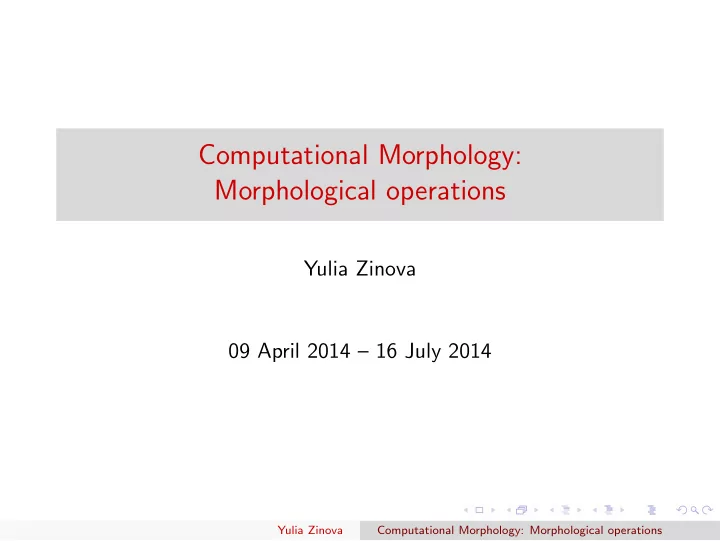

Computational Morphology: Morphological operations Yulia Zinova 09 April 2014 – 16 July 2014 . . . . . . Yulia Zinova Computational Morphology: Morphological operations
Root-and-Pattern Morphology ▶ Best-known example of root-and-pattern morphology: derivational morphology of the verbal system of Arabic; ▶ the first formal generative treatment – McCarthy (1979); ▶ Semitic languages derive verb stems - actual verbs with specific meanings - from consonantal roots; ▶ the overall prosodic “shape” of the derivative is given by a prosodic template (in McCarthys original analysis a CV template) ▶ the particular vowels chosen depend upon the intended aspect (perfect or imperfect) and voice (active or passive). . . . . . . Yulia Zinova Computational Morphology: Morphological operations
Examples ▶ Active forms with the root ktb “notion of writing” Pattern Template Verb Stem Gloss I C 1 aC 2 aC 3 katab “wrote” II C 1 aC 2 C 2 aC 3 kattab “caused to write” III C 1 aaC 2 aC 3 kaatab “corresponded” IV aC 1 C 2 aC 3 aktab “caused to write” VI taC 1 aaC 2 aC 3 takaatab “wrote to each other” VII nC 1 aC 2 aC 3 nkatab “subscribed” VII C 1 aC 2 aC 3 katab “copied” X staC 1 C 2 aC 3 katab “caused to write” . . . . . . Yulia Zinova Computational Morphology: Morphological operations
General Architecture ▶ We will assume that we are combining two elements, the root and the vocalized stem; ▶ we define the root P as follows: P = ktb ▶ we assume that the templates are represented more or less as in the standard analyses; ▶ exception: the additional affixes that one finds in some of the patterns the n- and sta- prefixes in VII and X or the -t infix in VIII will be lexically specified as being inserted; ▶ This serves the dual purpose: ▶ making the linking transducer simpler to formulate; ▶ underscoring the fact that these devices look like additional affixes to the core CV templates (and presumably historically were). . . . . . . Yulia Zinova Computational Morphology: Morphological operations
Transducers τ I = CaCaC τ II = CaCCaC τ III = CaaCaC τ IV = [ ϵ : a ] CCaC τ VI = [ ϵ : ta ] CaaCaC τ VII = [ ϵ : n ] CaCaC τ VIII = C [ ϵ : t ] aCaC τ X = [ ϵ : sta ] CaCaC τ = ∪ p ∈ patterns τ p . . . . . . Yulia Zinova Computational Morphology: Morphological operations
Last transducer ▶ Now we need a transducer to link the root to the templates; ▶ It must do two things: ▶ it must allow for optional vowels between the three consonants of the root; ▶ it must allow for doubling of the center consonant to match the doubled consonant slot in pattern II. ▶ The first part can be accomplished by the following transducer: λ 1 = C [ ϵ : V ] ∗ C [ ϵ : V ] ∗ C ▶ The second portion the consonant doubling requires rewrite rules (Kaplan and Kay, 1994; Mohri and Sproat, 1996) of the general form: λ 2 = C i → C i C i ▶ Then the full linking transducer λ can be constructed as: λ = λ 1 ◦ λ 2 . . . . . . Yulia Zinova Computational Morphology: Morphological operations
Getting everything together ▶ The whole set of templates for ktb can then be constructed as follows: Γ = P ◦ λ ◦ τ . . . . . . Yulia Zinova Computational Morphology: Morphological operations
Other approaches ▶ Most large-scale working systems for Arabic such as Buckwalter (2002), sidestep the issue of constructing verb stems and effectively compile out the various forms that verbs take. ▶ This is reasonable, given that the particular forms that are associated with a verbal root are lexically specified for that root, and the semantics of the derived forms are not entirely predictable. ▶ Another approach taken is that of Beesley and Karttunen (2000) who propose new mechanisms for handling non-concatenative morphology including an operation called compile-replace . ▶ The basic idea behind this operation is to represent a regular expression as part of the finite-state network, and then to compile this regular expression on demand. . . . . . . Yulia Zinova Computational Morphology: Morphological operations
Compile-replace: example ▶ Consider a case of total reduplication such as that found in Malay: a form like bagi “bag” becomes bagibagi “bags”. ▶ In Beesley and Karttunens implementation, a lexical-level form bagi+Noun+Plural would map to an intermediate surface form bagiˆ2 . ▶ This itself is a regular expression indicating the duplication of the string bagi , which when compiled out will yield the actual surface form bagi-bagi . ▶ Thus for any input string w , the reduplication operation transforms it into the intermediate surface form wˆ2 , which compile-replace then compiles out and replaces with the actual surface form. . . . . . . Yulia Zinova Computational Morphology: Morphological operations
Recommend
More recommend